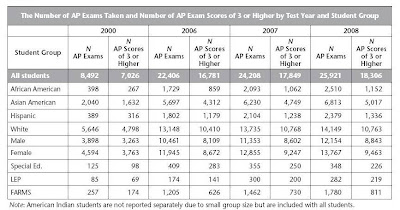The worsening relationship between MCPS Superintendent Jerry Weast and the County Council combined with Weast’s scheduled departure in 2011 calls into question the future of the school system. Let’s move beyond the politics and look at the facts on the ground.
1. In 1970, roughly 95% of Montgomery County public school students were white. Today, they are 38% white, 23% African American, 23% Latino and 16% Asian American. MCPS claims it has students from more than 164 countries speaking 134 languages. This is an incredibly diverse student body.
2. The percentage of students receiving free or reduced price meals has risen from 22% of enrollees in FY 2001 to 27% today. English-for speakers-of-other-language (ESOL) students have grown from 7% of enrollees in FY 2001 to 12% today. These students require extra effort to help them achieve at the same levels as wealthy children or English speakers.
3. Despite these challenges, a higher percentage of MCPS African American students scored a 3 or higher on Advanced Placement exams (19.6%) than did all students nationwide (15.2%) in the Class of 2008. Latinos did even better (32.2%). MCPS scores were superior to the average for Maryland, which is ranked as the number one statewide public school system in the country.
4. Between 2000 and 2008, every demographic category of the student body recorded massive increases in both the number of Advanced Placement exams taken and the number of scores at 3 or higher. The numbers went up even more in 2009. This is extremely important for college preparation.
5. For the Class of 2001, 28.9% of MCPS African American students earned a college degree – very close to the national average for all students (29.6%). The rate for MCPS Latinos (24.2%) was not much lower.
Given the demographic context for MCPS, the odds-on result would be falling performance. But MCPS has more than held its own. If that success is to continue, the following issues must be addressed.
1. ESOL students and free-and-reduced meal students are only going to increase as a percentage of the student body. That imposes rising costs on the school system that the county cannot escape. It must either fund those costs and support efforts to adequately educate these students or the system’s quality will fall.
2. The county is in sharp competition with other school districts for talent. Fairfax is competitive with MCPS in every way. D.C. Superintendent Michelle Rhee may ultimately succeed in pushing through a massive pay increase for teachers who forgo tenure. And even though Frederick and Howard Counties may pay less in teacher salaries, their cost of living is much lower than in Montgomery County. While the county may not be able to afford significant wage increases for the moment, many more years of low or non-existent wage hikes will hit Montgomery’s teacher talent base hard.
3. The Board of Education and the County Council are weary of Jerry Weast’s power and his ready willingness to use it. They may be tempted to pick a weakling to succeed him. That will only damage the school system. Weast’s successor must be a strong leader who continues to collaborate with labor, encourages innovative programs like peer-assisted review for teachers, spreads money around to poorer schools and focuses relentlessly on measurable outcomes.
The stakes are high and go far, far beyond clashes of power and ego. Montgomery County is in a fierce economic competition with Fairfax whether its leaders sufficiently appreciate that fact or not. Fairfax has lower taxes than Montgomery in every category except property. The one factor that keeps Montgomery in the game is that its public schools match those in Fairfax. So the county’s leaders will have to bear down and focus on keeping that edge.
Even if it means another eighteen months of dealing with the Rogue Superintendent.
Thursday, December 03, 2009
The Rogue Superintendent, Part Four
Posted by
Adam Pagnucco
at
7:00 AM
![]()
![]()
Labels: Adam Pagnucco, Jerry Weast, MCPS, Rogue Superintendent

